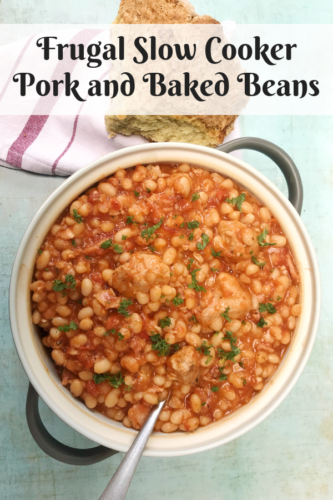My husband is a yellow sticker bargain ninja. He’s forever coming home with bargains he’s found at the supermarket, some things go straight in the freezer, but fresh fruit and vegetables need to be used within a day or two.
This week he came home with two packets of Mixed Roasting Vegetables from the Co-op which should have been £1.50 each, but were reduced to 83p each. The packs contained a small swede, 3 carrots, 2 parsnips and two medium sized onions. They were crying out to be used in a stew, so that’s what I did.
There was quite a lot of chopping involved in this stew, and I threw in some lentils and a leek I already had which was beginning to see better days. The result was so tasty and hearty that I’ll be making it again. It was a giant stew, which filled my slow cooker to the brim and took 8 hours to cook.

It fed our family for three meals. I made stew and dumplings, I turned it into a pie and I just served it as stew with mashed potato. I even managed to freeze a portion for a rainy day.
This recipe uses two of the packs of vegetables, but you can half the quantities of everything if you want to make a smaller stew. With the yellow sticker bargain, I reckon I made this huge stew for around £3.
Slow Cooker Root Vegetable Stew
Ingredients:
2 medium sized onions, chopped
1 leek, sliced
1 tablespoon of oil, whatever you have
2 small swedes, diced
2 parsnips
3 carrots
2 large potatoes
75g red lentils, rinsed
2.5 pints of vegetable stock (made with a stock cube)
1 tin of chopped tomatoes
2 cloves of garlic, crushed
1 tablespoon of tomato puree
1 tablespoon of mixed herbs
2 bay leaves
1 teaspoon of sugar
Salt and pepper
1 tablespoon of sweet chilli sauce
1 tablespoon of tomato ketchup
How to make your Slow Cooker Root Vegetable Stew
Chop your onions and cook them in half a tablespoon of oil until they are soft. Add them to the slow cooker when soft. Slice your leek and fry that until tender in the rest of the oil. Add the garlic towards the end of cooking and stir that through for a few minutes, when that’s cooked, tip the leeks and garlic into the slow cooker.
Peel and chop your swedes, carrots, parsnips and potatoes into similar sized pieces and add to the slow cooker.
Switch your slow cooker onto high and add the stock, chopped tomatoes, lentils and the rest of the ingredients. Put the lid on and cook until all the root vegetables are soft, for me this took 8 hours.
Once the vegetables are cooked, taste the stew and add more seasoning if you think it needs it. Stir through and serve however you want.

My favourite way we had the stew was with dumplings. It was just the most perfect warming, hearty meal and I know I’ll be craving stew and dumplings now every time the temperature dips. My husband loved the pie, which was just a dish of the stew, which I stirred a tablespoon of vegetable gravy granules through and topped with a puff pastry lid. But it’s just as good served with a pile of buttery mash.
If you enjoyed this, you might like to try these slow cooker recipes:
- Slow Cooker Pork and Beans
- Beef in Red Wine
- Ham Hock Macaroni Cheese
- Spanish Bravas Sausage Casserole
- Vegetarian French Onion Soup




